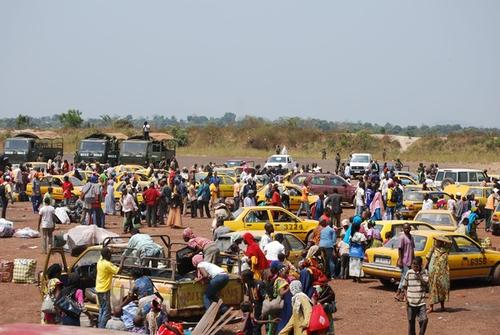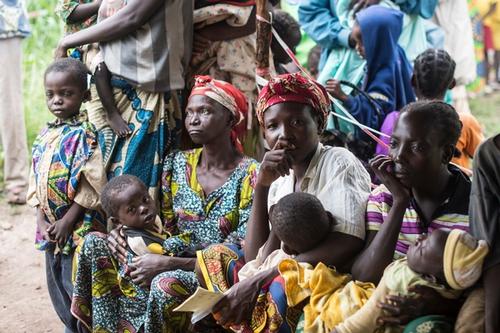Julian Donald, project coordinator for Médecins Sans Frontières (MSF), describes the crisis in Bossangoa, Central African Republic, and the surrounding Ouham Prefecture, where nearly the entire population has fled into the bush. This interview was conducted on December 11, 2013, just a few days after the latest episode of intense violence between armed groups in Bossangoa.
Q: What has happened in Bossangoa since the violence in September, two weeks before you arrived?
Anti-Balaka forces attacked the Seleka troops here in Bossangoa in September and withdrew again almost immediately. That led to a brief power vacuum in the city which led to widespread looting. About 30,000 people withdrew to the Catholic Mission, which was most of the town's population. It was extraordinarily congested. We immediately began work on latrine construction and other water and sanitation activities, drainage and waste collection, to try to improve the quality of life there.
After the September attack, the situation in Bossangoa itself was reasonably stable, but there were more or less daily reports of violence in the surrounding countryside. Many smaller villages were burned or looted, and in almost all of them, the population fled into the bush.
By my estimates, there are about 120,000 people displaced and living in the bush within 60 or 80 kilometres of Bossangoa, plus the 30,000 or so in the Catholic Mission camp, plus another 5,000 to 7,000 people living in the other two camps in Bossangoa. This is all in Ouham Prefecture.
Q: What do we know about the conditions of people who are out in the bush?
A couple weeks ago, we began running clinics in five locations outside of Bossangoa and we found a very desperate situation. Some people had been living in the bush since the coup in March, and we heard horrific stories — villages being burned, women raped, people killed. Many people lost all their possessions. Even if their house wasn't burned, it may have been looted after they fled. All the various warring parties have killed or stolen animals to feed their troops. A lot of people have lost crops or animals, and the food security situation in the countryside is desperate as we move into the dry season.
Q: What conditions are you seeing through these mobile clinics?
The number one problem is malaria. We find close to 100 percent positivity when we do our malaria checks. We are treating adults with severe symptoms when we encounter them, but we're focusing our mobile activities on children under 5 as they are the most vulnerable.
Because people have been living without shelter or mosquito nets, sleeping in forests or swamps, the malaria rate is enormous. It's shocking. When you combine that with diarrhea caused by drinking from unsafe water sources and the food shortages, people are quickly losing weight, especially children. Some children are extremely skinny and are being treated for severe acute malnutrition. There are children with open sores all over their legs and arms. I have rarely seen a situation so desperate.
Q: Where are you finding them?
We go to an abandoned village and walk into the bush until we find a family, and some of their people will go find other people and so on. They'll tell mothers to bring their children to our mobile clinic on the road, and we'll work there for several hours. But we suspect that we're not reaching the worst cases, because the people we are seeing are the ones who are well enough to come to our clinic. By returning to locations on a weekly basis, we hope we will enable more people to reach us.
Q: What are you able to treat people for?
We treat for parasitic infections, malaria and malnutrition. That's all we're able to do right now because of the number of cases. For example, we visited a town called Boubou, which is about 34 kilometres east of Bossangoa, and we found 180 children under five years of age. Of those children, 169 tested positive for malaria, seven were acutely, severely malnourished, and 20 were on the edge of becoming severely malnourished. So we provided Plumpynut for the malnourished children, and we provided antimalarial and antiparasitic drugs to all the rest.
Q: Are many people dying?
It's been very hard to get reliable mortality data, but the number of reported deaths is increasing. Most are children or the elderly, which would indicate that probably malaria or malnutrition are the biggest killers because those diseases tend to kill the most vulnerable first.
Q: How does the health of people in the bush compare to those in camps in Bossangoa?
In terms of nutrition, I would say that they're better off in Bossangoa. WFP has carried out food distributions there. As for malaria, all these people living in such close quarters in Bossangoa have the same kind of malaria rates that we see in the bush. So a few weeks ago we set up a series of health points in the camps which identify and treat malaria cases. We have already seen a decrease in the number of people coming to the hospital with malaria and now a decrease in the number coming to the health posts as well. However, the fighting on December 5 disrupted this activity.
Q: How has the violence affected your operations in Bossangoa?
Our hospital has been fully operational since the end of the heavy gunfire on December 5. As the battle finished we started receiving casualties immediately. Within the town and the camp itself, it has been harder to restart all our activities because our national staff, some of whom have lost family members or who have lost their worldly possessions, have had difficulty coming to work.
But at the same time, some of those health workers have gone well beyond their job descriptions. In the Muslim quarter, on the night of December 5, our staff in these health points suddenly found themselves on the front line of a battle, so we were supplying them with dressing material because they had so many wounded people coming in. They were the only people in the area who had any medical training.

Our staff in these health points suddenly found themselves on the front line of a battle, so we were supplying them with dressing material because they had so many wounded people coming in. They were the only people in the area who had any medical training.Julian Donald
Q: How much of the medical needs are injuries from violence?
It's a little hard to say. Before the recent fighting, over 70 percent of our surgical patients in the hospital have been violence-related cases. We had 40 wounded patients from the fighting on the weekend of December 5, Our small medical team was really stretched. Our surgical team was phenomenal, working basically nonstop. In the days that I was in the hospital we only had one patient come in who died as a result of his wounds, and we were able to save all the others. We do have a few cases that are still in critical condition, and we had one woman who was dead on arrival at the hospital.
Q: Why aren't other aid actors meeting the needs in and around Bossangoa?
The humanitarian response in Bossangoa has been very small. MSF has often felt alone as none of the other actors, and certainly not the UN, seemed to be scaling up in proportion to the needs of the population. Our core activity is medical work but we felt obliged to step in to provide water, latrines, showers and waste management for 30,000 people to prevent people from becoming very sick.
All the other organizations that you would associate with a situation like this are just not present here, except for ACF [Action Against Hunger/Action Contre la Faim]. That's a message that we've been trying to push for a long time, that there needs to be more international humanitarian action here, because there is a very large, very desperate population, and it is just not possible for us to do everything.



